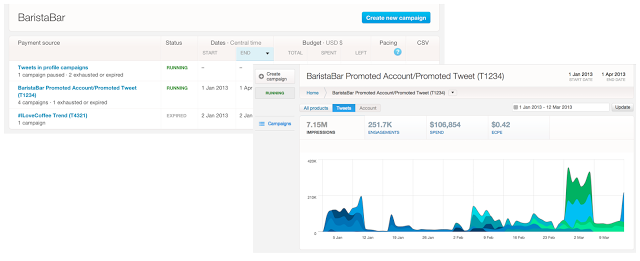
On Twitter’s route to growing revenues — forecast to be $1 billion this year — the social network has been making a lot of upgrades to its advertising services — most notably through a new advertising API. Today, it added to that with the release of a upgraded dashboard for the Twitter Ads center. The new interface provides significantly more data to make it easier for brands to measure how ads are performing on the network, in a bid to get those brands engaged and spending more on the platform.
In effect, this is Twitter advertising’s equivalent of adding in more comfortable furniture and some iced drinks to get brands and other businesses to hang out a bit longer. In the digital ad world, it’s about providing significantly more data in order to be able to measure and parse how ads perform, to justify how and where you will spend subsequent marketing budget.
One of the big focuses, Twitter says, is a focus on campaign analytics. All engagements on Promoted Tweets now will be included — those paid for by advertisers, as well as those from earned media.
Earned media, meanwhile, gets its own metrics now, too. It’s interesting to see that Twitter is now also stepping in to measure how brands, services and different companies are being mentioned even through unpaid media. Another sign of how it is widening its analytics net.
But the widening of what constitutes advertising and promotions is also seeing some scrutiny on another front: the Federal Trade Commission in the U.S. is currently looking into how social networks like Facebook and Twitter designate short-form ads as such in their news streams. As more ad formats grow, this will be an even stronger focus on this, with disclosures being required so that a “significant minority of reasonable consumers” do not get misled.
Other new features in today’s dashboard speak to the big data play that we are seeing across other mobile and social media ad networks. They include more detailed campaign reporting covering data points that Twitter tracks about its users and their location. “Regardless of how a campaign is set up, advertisers will have a clear understanding of how different targetable audience segments engage with Promoted Tweet and Promoted Account campaigns — by device, location, gender and interest,” Twitter’s product manager for revenue, Christopher Golda, notes.
Taken with the API, this is a sign of how Twitter is becoming significantly more sophisticated about what data it presents to its customers — advertisers.
For consumer users, it’s a signal that we should expect significantly more ad units and ad tech to be entering our Twitterverses in the months to come.